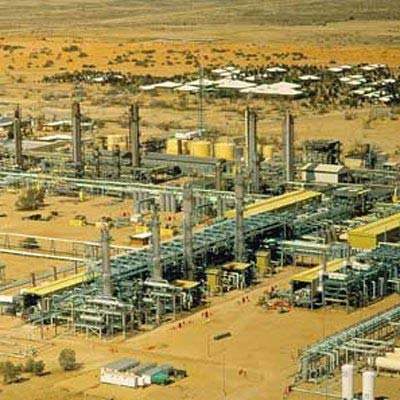
The Cooper oil exploitation programme is an early-stage exploitation strategy to improve the recovery of undeveloped oil from a proven hydrocarbon province through the application of modern technologies. The area covered by the project stretches across north-east South Australia and south-west Queensland on land owned by Santos Ltd.
In 2006 the Santos share of committed capital expenditure for the project was $160m which was to fund initial infrastructure costs, together with the drilling of approximately 100 wells.
The initial programme is targeting net proven plus probable (2P) reserves of six to seven million barrels (mmbbl). In all, the total programme between now and June 2010 could see gross capital expenditure of up to $1.3bn of which Santos’s share would be around $900m.
This would see 1,000 wells drilled targeting 75mmbbl of reserves, of which Santos share would be around 50mmbbl. Of this total programme, it is currently estimated that the South Australian portion could include up to 400 wells, with a gross capital expenditure of approximately $460m.
COOPER OIL EXPLOITATION PROJECT LOCATION
The project is located in the Cooper / Eromanga Basins, onshore central Australia in south-west Queensland, approximately 1,050km west of Brisbane. Oil was first discovered in 1981 in the area and a pipeline from Jackson to Moonie was opened in 1984 to transport the crude to refining assets.
Santos’s share of oil production from the Cooper Basin to date is just over 100mmbbl; however, the company’s share of estimated proven plus probable plus possible (3P) oil in place is around 700mmbbl.
Santos already has a successful gas liquids recovery plant at Moomba in the Cooper Basin which in January 2004 was damaged by an explosion; it underwent a fast track remediation programme undertaken by Aker Kvaerner Australia Pty Ltd and United KG Pty Ltd on both trains A and B and this has been back in commission since the start of 2005.
The Moomba plant is operating in full liquids recovery mode for the extraction of natural gas liquids such as LPGs and ethane. The repairs cost an estimated A$200m. System GA Pty Ltd also carried out some work on the plant’s heat exchanger system. An expansion project for the plant is being considered.
COOPER OIL
The Cooper Oil Project (COP) is an accelerated drilling and field development programme aimed at substantially increasing oil production and reserves in response to higher oil prices and the application of modern technologies.
This includes the use of the latest 3D seismic technologies and interpretation techniques to identify new exploration and development drilling locations, to increase drilling success rates and to better define fields to enable them to be more efficiently developed. Santos already has extensive 3D seismic data coverage and continues to acquire additional surveys to enable it to further build on the company’s comprehensive knowledge of the Cooper Basin area.
COP drilling was started in early 2006 using the first of four automated truck-mounted drilling rigs. The use of these new automated rigs for COP has substantially reduced drilling times with the average oil well now taking only approximately one week to drill.
The new rigs have the additional advantage of being self-levelling, thereby requiring less site works and leaving a smaller environmental footprint to be rehabilitated. The rigs also have operational safety advantages and run at a lower unit cost than conventional units.
COP EXPLORATION AND DEVELOPMENT
At total of 108 wells were drilled in 2006 with a high success rate of 80%. Proved plus probable reserves additions for Santos were 15mmbbls in this period with an average initial online rate per successful well of 156bopd (barrels of oil per day).
The oil production rate from COP activity will continue to rise as additional wells which were cased and suspended in 2006 are brought online in 2007. A total of A$186m was spent by Santos in 2006 at an assessed full cycle finding and development cost of A$22 per barrel of oil. The 2006 programme included substantial expenditure on infrastructure, oil processing facilities and water injection facilities and wells.
Secondary recovery through water injection into the reservoir has been identified as a key driver for increasing oil reserves and production. These facilities were commissioned in early 2007 and the benefits on production and reserves will become more apparent as the volumes of injected water increase.
CONTINUING PROGRAMME
Cooper oil project activity is planned to continue at an accelerated pace in 2007 with the expenditure of $330m Santos share and up to 190 wells drilled.
The total COP programme between now and 2010 could see up to 1,000 wells drilled targeting 60mmbbl of reserves net to Santos.
In June 2007 Cooper Energy added two Worrior oil field appraisal / development wells to the 2007 drilling schedule. These wells, if successful, are expected to boost production and reserves of the Worrior oil field in PEL93, which will assist in sustaining Cooper Energy’s future oil production volumes and sales revenue.
A total of eight wells are now expected to be drilled in the second half of 2007; four exploration wells and four appraisal / development wells in the Cooper Basin. Other companies with interests in this area include Stuart Petroleum, Avery Resources (Toperoa production), Strike Oil and Beach Petroleum.
CARBON SEQUESTRATION
In June 2007 on the back of the successful oil production programme Santos has also unveiled a proposal for a A$714m ($588m) carbon dioxide sequestration project which would use its depleted oil and gas reservoirs to store CO2 deep underground.
The Santos proposal is for the Moomba Carbon Storage (MCS) project, which will be capable of storing more than 400 million tonnes of carbon dioxide. Carbon dioxide from three states would be piped back to the Cooper Basin gas fields and re-injected into sub-surface rocks to dramatically reduce national emissions by about 20 million tonnes a year.

